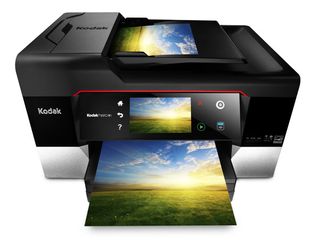Kodak: 60% better off with other printers
60% of people are better off not using a Kodak printer

Up to 60% of people are better off not using a Kodak printer according to Robert Ohlweiler, Kodak's Director of Consumer Inkjet for Europe, Africa and Middle East.
Ohlweiler explains that most printer manufacturers use a business model that means they make much more money from ink sales than printer sales. In fact, he says that for every £1 spent on a printer, approximately £3 is spent on ink. Kodak takes a different approach by charging a bit more for its printers so that it can keep its ink costs down.
According to Kodak research, the low printer cost, high ink price model suits the majority (around 60%) of people who make very few prints. However, 'photo-active families', home-office users and those who make a lot of prints get better value from the Kodak approach.
Kodak's calculations indicate that those who print more than 4 pages a day (on average) would be better off switching to a Kodak printer.
As it launched its first inkjet printer in August 2007, Kodak is a relative newcomer to the market. Nevertheless, the company has managed achieve the number two position for UK sales by value for the last four months, and also for number of units sold during May and July 2011. Kodak's main battle for this step on the marketplace podium is with Epson, HP consistently achieves the top position.
Ohlweiler believes that Kodak has achieved its high status in the marketplace by addressing three key areas of concern for consumers, ink price, image quality over time and ease of use.
He says that Kodak printers produce high quality, long-lasting prints because the company uses pigment based inks. Testing by Wilhelm Imaging Research Inc indicates that prints made using Kodak printers, ink and media have a lifespan in excess of 100 years.
Get daily insight, inspiration and deals in your inbox
Get the hottest deals available in your inbox plus news, reviews, opinion, analysis and more from the TechRadar team.
In a bid to make its printers easier to use, Kodak has fitted many with sensors to detect the type of paper that is being used. One sensor looks at the paper surface and can distinguish between glossy and plain papers and thus give a 'best guess' of the correct media setting to use. A second can read the faint barcode on the back of Kodak paper and this sets the print media precisely, without the user having to open the printer driver.
